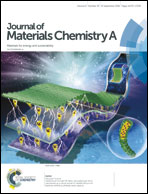Activity enhancement via borate incorporation into a NiFe (oxy)hydroxide catalyst for electrocatalytic oxygen evolution†
Abstract
The oxygen evolution reaction (OER) is a key process in electrocatalysis and is critical for achieving the cost-effective conversion of renewable electricity to chemicals and fuels. However, the high overpotential (η) originates from poor charge-transfer ability and low catalytic activity may lead to high power consumption. Herein, we alleviate these issues by introducing borate into the NiFe (oxy)hydroxide framework. Our density functional theory (DFT) calculations demonstrated that the borate could be efficiently adsorbed onto the Ni/NiFe (oxy)hydroxide surface. Microscopically, the adsorbed borate can induce a favorable electronic structure for the Ni active sites. Meanwhile, the macroscopic charge-transfer ability of this synthesized catalyst has been dramatically increased. Hence, the catalytic performance of this material is improved compared with its NiFe counterpart: we achieved a higher OER activity with an ultralow η of only 230 mV at 10 mA cm−2 on a glassy carbon electrode (GCE) and of 200 mV at 10 mA cm−2 on Ni foam in alkaline medium. Moreover, this borate mediated NiFe (oxy)hydroxide is very stable: no appreciable degradation is observed after more than 110 hours of operation.



 Please wait while we load your content...
Please wait while we load your content...